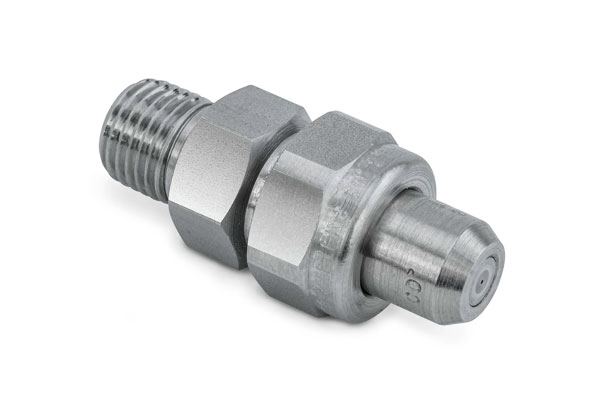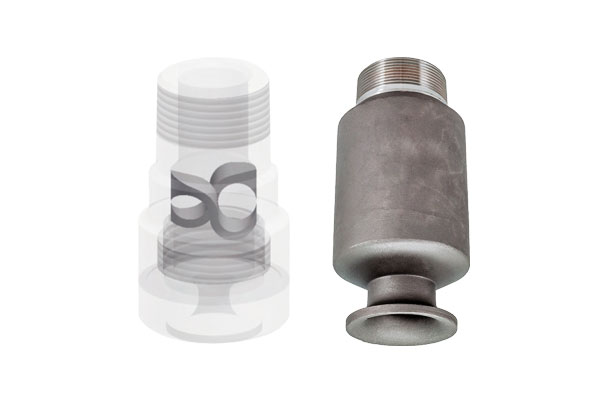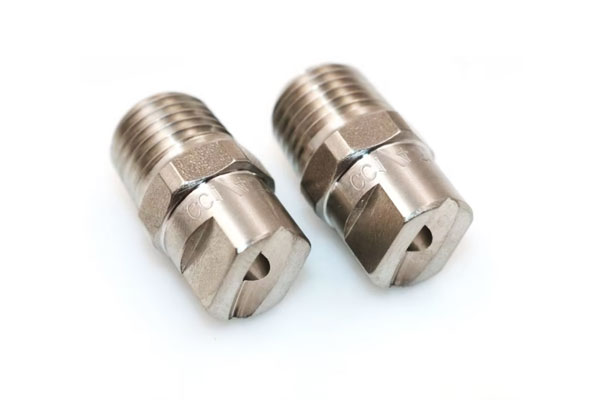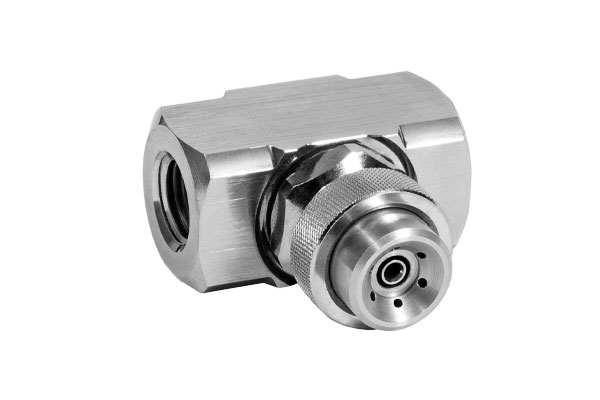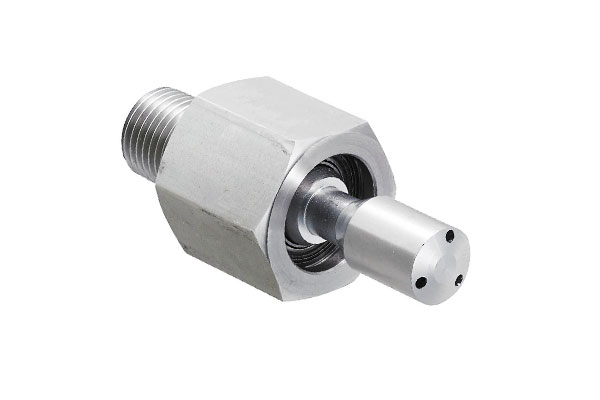1. Panimula
The Stainless Steel Nozzle is more than just a fluid-dispensing component—it is a precision-engineered device that directly influences process efficiency, product quality, and operational safety across diverse industries.
From generating ultra-fine mists in pharmaceutical cleanrooms to delivering high-impact jets in steelmaking and power plants, stainless steel nozzles translate engineering principles into practical performance.
Unlike plastic or brass counterparts, stainless steel nozzles combine mekanikal na katatagan, paglaban sa kaagnasan, and hygiene compliance, making them indispensable in mission-critical environments.
By mastering both dinamika ng likido (daloy ng rate, spray angle, laki ng droplet) at metalurhiya (material grades, tapos sa ibabaw, paggamot ng init),
Stainless steel nozzles deliver pare-pareho, maaasahan, and long-term performance even under extreme conditions such as cryogenic temperatures, mataas na presyon, or corrosive chemical exposure.
2. What is a Stainless Steel Nozzle?
A stainless steel nozzle is a precision-engineered device designed to control the direction, daloy ng rate, bilis ng bilis, and spray characteristics of liquids or gases as they exit a piping or pressurized system.
Sa core nito, the nozzle acts as a fluid-shaping component, transforming static pressure into dynamic energy, thereby creating sprays, jets, mists, or atomized particles tailored for specific industrial requirements.
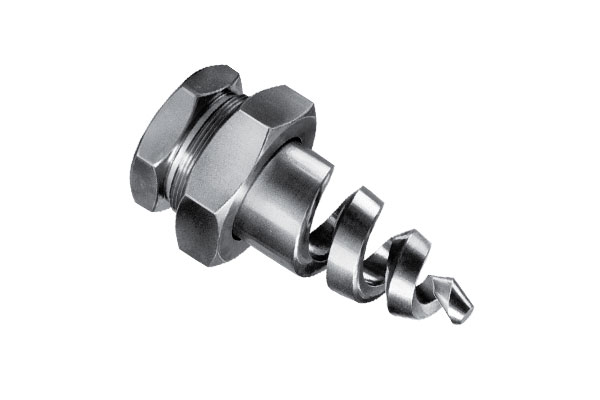
From a physics perspective, the nozzle functions on the principles of fluid dynamics and spray science.
The geometry of the nozzle—whether convergent, divergent, or multi-orifice—directly influences flow coefficient (Cv), pressure drop, droplet size distribution (Sauter Mean Diameter, SMD), and spray angle.
Halimbawa na lang, a fine atomization nozzle operating at 3 bar pressure can achieve droplet sizes below 100 μm, critical for applications such as cooling, humidification, o fuel injection.
3. Bakit hindi kinakalawang na asero? Material Properties for Nozzle Performance
The performance of a nozzle is inseparably tied to the material from which it is made.
For demanding industrial environments, hindi kinakalawang na asero (SS) has emerged as the preferred choice due to its unique balance of mechanical strength, paglaban sa kaagnasan, thermal katatagan, and manufacturability.
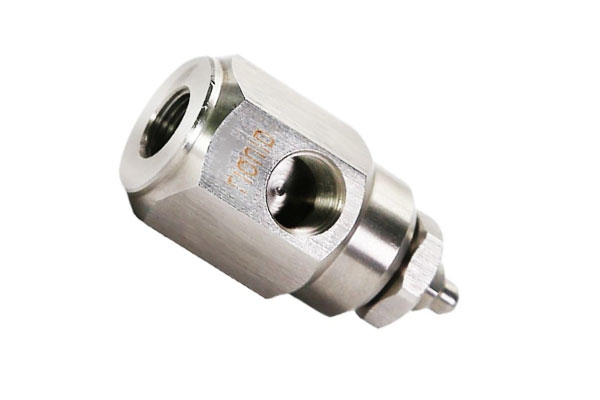
Paglaban sa kaagnasan
The defining property of stainless steel is its chromium-enriched passive oxide layer (≥ 10.5% Cr), which regenerates when damaged. This ensures protection against:
- Pangkalahatang kaagnasan (hal., in water spray systems).
- Pitting corrosion sa mga kapaligiran na mayaman sa klorido (316/316L is particularly resistant).
- Oxidation at elevated temperatures, essential for hot-gas injection nozzles.
Halimbawa: A 304 stainless steel nozzle exposed to neutral water shows a corrosion rate < 0.01 mm / taon, while a brass nozzle under the same conditions degrades 3–5× faster.
Lakas ng Mekanikal & Magsuot ng Paglaban
Stainless steel offers a high strength-to-weight ratio, kritikal para sa erosion-prone applications (hal., abrasive slurry spraying, high-pressure cleaning).
- Yield strength: 316L ~ 170–310 MPa; 410 (martensitic SS) ~ 450–650 MPa.
- Ang katigasan ng ulo: can reach 200–350 HB depending on alloy and heat treatment.
This allows stainless steel nozzles to withstand pressures exceeding 400 bar in ultra-high-pressure water jetting, where polymer or brass alternatives fail.
Cryogenic and High-Temperature Suitability
Unlike carbon steels, which lose ductility below -40 °C, austenitic hindi kinakalawang na asero (304, 316) retain toughness down to -196 °C.
At the other extreme, stainless steels can operate safely at temperatures up to 800–900 °C, Depende sa grado.
This dual capability explains why cryogenic spray nozzles (LIN, LOX systems) at gas turbine injection nozzles alike rely on stainless steel.
Manufacturability and Surface Finish
Stainless steels can be precision machined, laser-drilled, or investment cast, enabling complex orifice geometries with tolerances < ±10 μm.
Their compatibility with electropolishing at passivation treatments ensures smooth internal surfaces, minimizing turbulence, Email Address *, and microbial growth.
Key Stainless Steel Grades for Nozzles
| Grade | Lakas ng loob (Ani / Makunat) | Paglaban sa kaagnasan | Mga Pangunahing Tampok | Mga Karaniwang Aplikasyon |
| 304 / 304L | 200–240 MPa / ~520 MPa | Good in neutral media, weak in chlorides | Economical, Maaaring hinangin, magandang ductility | Cooling towers, water spray, dust suppression |
| 316 / 316L | 200–290 MPa / ~580 MPa | Napakahusay (Mo improves pitting resistance, PREN ~25) | Marine-grade, chloride/acid resistant, Sanitary | Chemical sprays, marine fire systems, pagkain & beverage cleaning |
| 410 / 420 (Martensitiko) | 450–650 MPa / hanggang sa 800 MPa; Hardness 45–52 HRC | Katamtaman, weaker vs. austenitic | Mataas na katigasan, wear resistant, Maaaring gamutin ang init | Abrasive spraying, high-pressure washing, slurry nozzles |
| 2205 Duplex | 450–550 MPa / ~700 MPa | Napakataas (PREN > 35, resistant to chloride SCC) | Malakas na, balanced ferrite-austenite structure, mahusay na katigasan | Mga platform sa malayo sa pampang, seawater injection, marine scrubbers |
| 17-4PH | >1000 MPa tensile (H900 condition) | Katamtaman (better than carbon steel, mas mababa sa 316) | Mataas na lakas, fatigue resistant, precipitation hardened | Aerospace spray systems, compact hydraulic nozzles |
| Specialty Alloys (904L, haluang metal 20, Hastelloy C-22) | Iba-iba ang, Karaniwan >400 MPa | Pambihirang (handles strong acids and oxidizers) | Extreme corrosion resistance, expensive | Mga reaktor ng kemikal, acid scrubbers, nuclear/pharma nozzles |
4. Nozzle Types & How They Perform
Stainless steel nozzles are engineered to produce precise spray patterns, droplet sizes, and flow rates for specific industrial applications. Selection depends on fluid properties, operating pressure, and the desired spray effect.
Mga guwang na cone nozzle
- Principle: Fluid enters a swirl chamber, where it is forced to spin rapidly due to tangential vanes or an internal spiral structure.
This rotational motion causes the fluid to exit through the orifice in a thin, ring-shaped spray, creating a hollow cone pattern.
The centrifugal force ensures that the droplet distribution concentrates along the spray perimeter, leaving a relatively empty core.Stainless Steel Hollow Cone Nozzle - Pagganap: Produces fine droplets concentrated along the periphery, kasama ang Sauter Mean Diameter (SMD) typically 80–200 µm at 2–5 bar.
- Mga Aplikasyon: Cooling towers, gas scrubbing, and dust suppression, where surface coverage along the spray perimeter is critical.
- Mga kalamangan: Efficient surface wetting with minimal fluid consumption; self-cleaning behavior reduces clogging.
- Mga Limitasyon: Less uniform coverage at the center; sensitive to pressure fluctuations.
Buong Cone Nozzles
- Principle: Fluid enters a swirl chamber or hits impingement pins inside the nozzle, which evenly distributes it across the entire cross-section of the exiting spray.
This produces a solid, fully filled conical spray where droplet density is relatively uniform from the center to the outer edge, suitable for applications requiring uniform coverage.Stainless Steel Full Cone Nozzle - Pagganap: Produces uniform droplet distribution; SMD typically 100–300 µm depending on viscosity and pressure.
- Mga Aplikasyon: Boiler burners, Mga reaktor ng kemikal, agricultural spraying, and fire protection systems.
- Mga kalamangan: Excellent coverage, high impact energy, compatible with viscous fluids.
- Mga Limitasyon: Larger free-passage designs required for particle-laden fluids; can produce higher drift in windy conditions.
Flat Fan Nozzles
- Principle: Fluid is forced through a slotted orifice, sometimes with a deflection plate or fan-shaped cavity, creating a thin, fan-like sheet of liquid.
The sheet spreads laterally, forming a planar spray that maintains a nearly uniform thickness across the fan width. Spray edges are shaped by the orifice geometry and flow velocity.Stainless Steel Flat Fan Nozzles - Pagganap: Droplet sizes vary 100–400 µm depending on orifice size and operating pressure; spray angle adjustable from 15° to 120°.
- Mga Aplikasyon: Surface coating, conveyor washing, patubig, and pesticide application.
- Mga kalamangan: Wide, uniform coverage over a linear area; easy to arrange in banks for continuous surface coverage.
- Mga Limitasyon: Edges of fan may have thinner coverage; risk of streaking if pressure fluctuates.
Atomizing Nozzles
- Principle: Uses external energy, such as compressed air or steam, to break the fluid into fine droplets.
Air-assisted atomizers mix fluid with high-velocity air streams, airless atomizers rely on high liquid pressure to achieve shear, and ultrasonic atomizers vibrate a piezoelectric element to form extremely fine droplets.
This allows precise control of droplet size and spray density.Stainless Steel Atomizing Nozzles - Pagganap: SMD can reach 10–50 µm for ultra-fine sprays, ideal for humidification or coating.
- Mga Aplikasyon: Spray drying, iniksyon ng gasolina, pagpipinta, and misting systems.
- Mga kalamangan: Produces extremely fine droplets for evaporation or surface coating; precise control over spray density.
- Mga Limitasyon: Requires compressed air or secondary energy source; higher complexity and cost.
Epekto & Impingement Nozzles
- Principle: Fluid jets collide with a target surface or intersecting jets, causing the liquid to atomize due to momentum transfer and surface tension disruption.
The spray is formed mainly at the point of impact, creating localized high-energy droplets suitable for cleaning or surface treatment.Stainless Steel ROTARY Impact Nozzles - Pagganap: Droplets range 100–500 µm; impact energy enhances surface adhesion or mechanical cleaning.
- Mga Aplikasyon: Paglilinis ng industriya, surface treatment, and dust suppression.
- Mga kalamangan: Mataas na epekto ng enerhiya, effective for washing or removing debris; simple design.
- Mga Limitasyon: Coverage limited to local impact area; not suitable for uniform misting.
5. Mga Tampok ng Disenyo & Sealing Options
- Bodies & tips: One-piece vs replaceable tips for fast changeover. Integrated swirl chambers, vanes, o impingement pins define spray structure.
- Connections: NPT/BSPP/BSPT, tri-clamp (Sanitary), ISO/ASME flanges, o quick-connects.
- Mga Tatak & Mga Gasket: PTFE, PEEK, EPDM, FKM, FFKM selected by temperature/chemistry; metal-to-metal seats (mga kono) used for steam or abrasive service.
- Anti-clogging: Strainers (60–200 mesh), large free-passage designs, o self-cleaning retractable tips.
- Galling control: Dissimilar alloys, Nitronic 60, or solid film lubricants on threads (avoid hydrocarbon lubes in oxygen service).
6. Manufacturing Routes, Mga pagpapaubaya & Tapos na sa ibabaw
The performance of a stainless steel nozzle is determined not only by the alloy grade but also by how it is manufactured, ang dimensional tolerances achieved, at ang mga final surface condition.
Each factor directly impacts flow precision, Paglaban sa Pagsusuot, and service life.
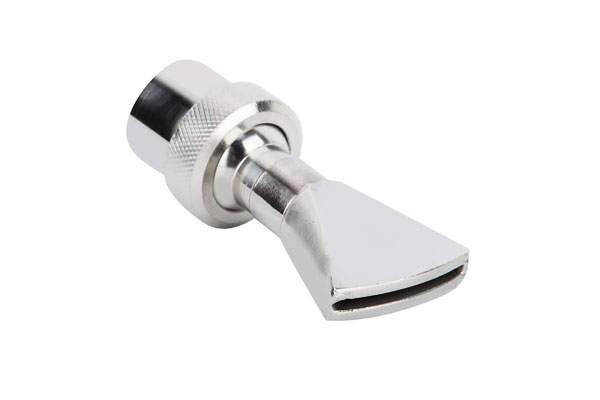
Manufacturing Routes
The choice of manufacturing route for stainless steel nozzles is dictated by geometry complexity, precision requirements, dami ng produksyon, and service environment.
The main methods include:
katumpakan paghahagis (Pamumuhunan sa Paghahagis)
- Mga Aplikasyon: Spiral, hollow-cone, or multi-orifice spray nozzles with complex internal passages.
- Mga kalamangan: Excellent design freedom; can produce intricate shapes in a single step.
- Mga Limitasyon: Surface roughness is higher (Ra ~3–6 μm), requiring post-machining for critical orifices. Dimensional tolerances are typically looser (±0.1-0.2 mm).
- Halimbawa: Cooling towers, dust suppression systems.
CNC Machining
- Mga Aplikasyon: High-precision nozzles used in fuel injection, mga turbine ng gas, semiconductor cleaning, and pharmaceutical processing.
- Mga kalamangan: Very tight tolerances (±0.01–0.02 mm); repeatability and consistency across large batches. Can achieve smooth bore profiles for predictable spray performance.
- Mga Limitasyon: Higher cost for complex geometries; machining time increases exponentially for micro-orifices (<0.2 mm).
- Halimbawa: High-pressure cleaning nozzles, spray dryers, fuel atomizers.
Powder Metallurgy & Paggawa ng Additive (AM)
- Mga Aplikasyon: Customized nozzles requiring lattice structures, Mga Channel ng Paglamig, or highly complex spray distribution patterns.
- Mga kalamangan: Allows designs impossible with machining (hal., internal swirl chambers). Rapid prototyping and low-volume production are feasible.
- Mga Limitasyon: Email Address * (Ra ~5–10 μm) usually requires polishing; mechanical properties depend on powder quality and sintering/fusion control.
- Halimbawa: Aerospace fuel injectors, medical atomization devices, advanced heat exchangers.
Gawa-gawa & Welding
- Mga Aplikasyon: Large-scale industrial nozzles (hal., steel mill descaling, chemical reactor quenching, proteksyon sa sunog).
- Mga kalamangan: Can produce oversized nozzles economically from pipes and forged blanks. Welding allows integration with headers and manifolds.
- Mga Limitasyon: Weld quality must be carefully controlled to prevent porosity, stress kaagnasan pag crack, or fatigue failure in cyclic service.
- Halimbawa: Boiler cleaning nozzles, refinery quench systems, fire suppression deluge systems.
Mga pagpapaubaya & Tapos na sa ibabaw
Ang tolerances and surface finish of a stainless steel nozzle are critical factors that directly affect spray uniformity, flow rate stability, erosion resistance, and overall service life.
Achieving precise dimensions and smooth internal surfaces requires careful selection of manufacturing methods, finishing techniques, and quality inspection standards.
Dimensional Tolerances
- Kahulugan: The allowable deviation from the nominal dimensions of the nozzle, kasama na ang orifice diameter, length, kapal ng pader, and taper angle.
- Typical Values by Manufacturing Method:
-
- CNC Machining: ±0.01–0.02 mm for critical orifices; ±0.05 mm for less critical external features.
- Pamumuhunan sa Paghahagis: ±0.1-0.2 mm; shrinkage compensation required.
- Paggawa ng Additive: ±0.05–0.15 mm; post-processing may tighten tolerances.
- Fabrication/Welding: ±0.2–0.5 mm; depends on welding distortion and assembly alignment.
- Engineering Insight: Even minor deviations in orifice diameter can significantly affect flow coefficient (Cv/K-factor) and spray pattern.
Halimbawa na lang, a 0.05 mm reduction in a 0.5 mm orifice may reduce flow by ~10%.
Tapos na sa ibabaw (Pagkamagaspang, Ra)
- Importance: Surface finish affects fluid friction, atomization quality, erosion resistance, and fouling tendency.
- Typical Ra Values:
-
- CNC Machining: Ra 0.2–0.8 μm after precision polishing; ideal for fuel injection and fine atomization.
- Pamumuhunan sa Paghahagis: Ra 3–6 μm; post-machining recommended for fine orifices.
- Paggawa ng Additive: Ra 5–10 μm; internal polishing or chemical smoothing improves flow.
- Fabrication/Welding: Ra 1–3 μm externally; internal surfaces may require grinding or electro-polishing.
- Advanced Surface Treatments:
-
- Electropolishing: Removes micro-burrs and improves corrosion resistance. Ra can reach 0.1–0.3 μm.
- Kemikal na Ukit: Reduces surface tension, improves spray consistency.
- Mekanikal na Kinis: Enhances flow uniformity and reduces clogging.
Relationship Between Tolerance, Tapusin, at Pagganap
- Atomization & Spray Angle: Smoother internal surfaces reduce turbulence, producing finer droplet size (SMD) and consistent spray angles.
- Flow Rate Accuracy: Tight tolerance ensures repeatable Cv/K-factor values across production batches.
- Tibay ng buhay: Low roughness reduces cavitation, erosion, at kaagnasan, extending service life.
7. Applications of Stainless Steel Nozzle
Stainless steel nozzles are critical components in a wide range of industrial, komersyal na, and environmental systems due to their durability, paglaban sa kaagnasan, and precision spray control.
Industrial Process Applications
- Pagproseso ng kemikal: Used for precise dosing, paglamig, or neutralization sprays. Stainless steel 316/316L nozzles resist corrosive chemicals, mga asido, at mga solvent.
- Mga Boiler & Steam Systems: Full cone and hollow cone nozzles atomize water or steam for efficient heat transfer and evaporation.
Metal-to-metal seated nozzles withstand high temperature and pressure. - Spray Drying: Atomizing nozzles create ultra-fine droplets for drying powders, mga parmasyutiko, and food ingredients, ensuring uniform particle size and consistent product quality.
Environmental & Pollution Control
- Gas Scrubbing & Dust Suppression: Hollow cone nozzles in scrubbers remove particulate matter from industrial exhaust streams. Spray patterns optimize contact between liquid and pollutants.
- Cooling Towers & Evaporative Cooling: High-efficiency hollow cone or full cone sprays provide uniform heat exchange and minimize drift.
Pagkain & Industriya ng Inumin
- Sanitary Applications: Tri-clamp stainless steel nozzles deliver precise washing, patong na patong, or liquid distribution in processing lines, complying with hygiene standards.
- Spray Coating & Flavoring: Flat fan nozzles evenly apply coatings, flavorings, or emulsions to products.
Agrikultura & Horticultural Applications
- Pesticide & Fertilizer Spraying: Flat fan or hollow cone nozzles achieve even coverage over crops while minimizing overspray and drift.
- Irrigation Systems: High-corrosion-resistant stainless steel nozzles maintain long-term performance in nutrient-rich water.
Fire Protection & Safety Systems
- Sprinkler & Deluge Systems: Full cone or impact nozzles provide high-impact water coverage for fire suppression in industrial and commercial facilities.
- Hazardous Material Mitigation: Stainless steel nozzles resist chemical attack while delivering precise spray for neutralization or cooling of flammable liquids.
Umuusbong na & Mga Dalubhasang Aplikasyon
- Parmasyutiko & Biotechnology: Atomizing nozzles enable aerosol generation, humidification, or coating in controlled environments.
- Marine & Malayo sa pampang: Corrosion-resistant nozzles withstand saltwater exposure in cooling, Paglilinis, or firefighting applications.
- Paggawa ng Additive & 3D Paglilimbag: High-precision stainless steel nozzles regulate molten material deposition or cooling sprays in industrial 3D printing.
8. Mga Pakinabang at Limitasyon
Stainless steel nozzles are widely used across industries due to their combination of mechanical strength, paglaban sa kemikal, and precision engineering.
Advantages of Stainless Steel Nozzle
Kaagnasan at Paglaban sa Kemikal
- Stainless steel grades such as 304, 316, and 316L resist oxidation, mga asido, alkalis, and many solvents, making them ideal for chemical processing, marine, and food applications.
- Halimbawa: 316L nozzles maintain structural integrity in 1–10% hydrochloric acid solutions for extended operational periods.
High Temperature and Pressure Performance
- Can operate in high-temperature environments, up to 870°C (Depende sa grado), without deformation or loss of spray pattern accuracy.
- Suitable for steam atomization, boiler spray, and thermal cleaning applications.
Lakas ng Mekanikal at Paglaban sa Pagsusuot
- Stainless steel resists erosion from abrasive fluids, particulate-laden sprays, or high-velocity atomization.
- Surface hardening treatments or Nitronic 60 inserts further extend nozzle life in abrasive service.
Katumpakan at Pagkakapare pareho
- Machined tolerances and polished internal surfaces provide accurate flow rates, laki ng droplet (SMD), and spray angle.
- Ensures reproducible performance in critical applications like spray drying, chemical dosing, and pharmaceutical atomization.
Hygiene and Sanitary Compliance
- Easily cleaned and sterilized, compatible with sanitary tri-clamp fittings and ISO/ASME flange standards.
- Suitable for food, inumin, and biotech industries.
Longevity and Lifecycle Cost Savings
- Despite higher initial cost, stainless steel nozzles offer longer service life than brass, plastik na plastik, or bronze alternatives.
- Reduced downtime and maintenance costs justify investment in critical operations.
Limitations of Stainless Steel Nozzle
Paunang Gastos
- Stainless steel nozzles typically cost 2–5× more than brass or plastic counterparts.
- Justifiable mainly in corrosive, mataas na temperatura, or abrasive applications.
Susceptibility to Galling
- Threads and mating surfaces can gall under friction, particularly in austenitic stainless steels.
- Requires careful material pairing, mga pampadulas (avoiding hydrocarbons in oxygen service), or coated threads.
Erosion in Extreme Abrasive Environments
- Although wear-resistant, stainless steel can erode over time when exposed to highly abrasive slurries. Harder alloys or inserts may be necessary.
Mga Pagsasaalang alang sa Timbang
- Stainless steel is denser than aluminum or plastic, which may be a limitation in lightweight portable spraying equipment.
Limited Flexibility
- Unlike plastic nozzles, stainless steel is rigid and cannot be easily shaped or bent for specialized custom spray angles.
9. Selection Workflow & a Quick Sizing Example
- Define medium (Kimika, solids, viscosity, temperatura).
- Select function (malinis na, cool na, coat, atomize).
- Choose pattern (cone, fan, mist, jet).
- Match flow & presyon (K-factor or Cv).
- Select material grade (316L, Duplex, atbp.).
- Verify finish & connection.
10. Pangwakas na Salita
Stainless steel nozzles exemplify the intersection of fluid mechanics, metalurhiya, and precision engineering.
With correct grade selection, tapos sa ibabaw, and performance verification, they deliver uniform spray, long service life, and reduced downtime across industries from food to power generation.
While they carry higher upfront costs, ang kanilang tibay ng katawan, hygiene compliance, at pagiging maaasahan make them indispensable in mission-critical processes.
Mga FAQ
Can investment casting produce stainless steel nozzles with internal threads?
Yes—threads (hal., NPT, BSP) can be cast directly if the pitch is ≥1 mm. For finer threads (<1 mm), foundries cast near-net-shape and finish with precision tapping.
How does investment casting compare to machining for stainless steel nozzles?
Machining is suitable for simple nozzles but is cost-prohibitive for complex designs (hal., multi-channel fuel nozzles), where 50–70% of material is wasted.
Investment casting reduces material waste to 5–10% and eliminates assembly of multiple machined parts.
What is the maximum size of a stainless steel nozzle produced via investment casting?
Most foundries specialize in nozzles up to 300 mm in diameter (hal., large steam turbine nozzles). For larger sizes (>300 mm), sand casting may be used, but with reduced precision.
Can stainless steel nozzles handle cryogenic temperatures (hal., LNG at -162°C)?
Yes—316L and 304 retain ductility at -196°C (no brittle fracture) and are used in LNG vaporizer nozzles. Avoid 321 sa < -50°C, as titanium stabilization reduces cryogenic toughness.
What is the maximum pressure a stainless steel nozzle can withstand?
Duplex 2205 nozzles handle up to 200 MPa (29,000 psi) for high-pressure gas service. Standard 316L nozzles are rated for 10–100 MPa, depending on size and design.
How do I clean a clogged stainless steel nozzle?
For mild clogging, flush with warm water + detergent. For mineral deposits, use a 5% nitric acid solution (safe for 304/316L). Avoid wire brushes (scratch the passive layer).

